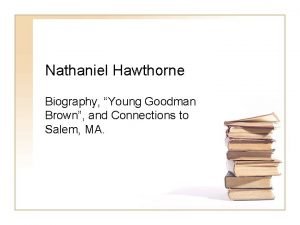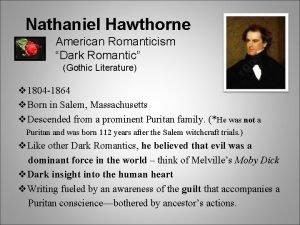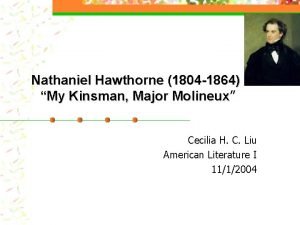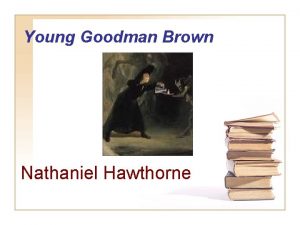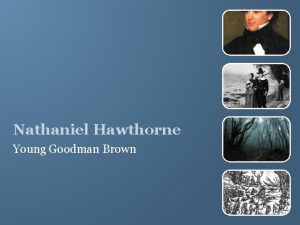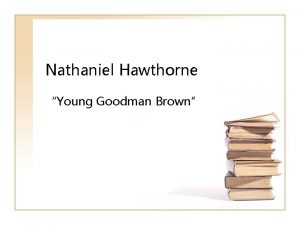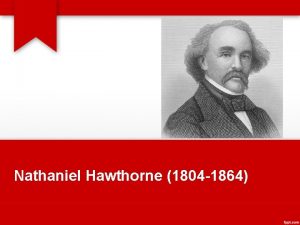The Scarlet Letter Nathaniel Hawthorne Theme Hawthorne focuses
























- Slides: 24

The Scarlet Letter Nathaniel Hawthorne

Theme • Hawthorne focuses his attention on the problem of evil and the nature of sin. • He analyzes the inner world of the human mind and heart. • In The Scarlet Letter, Hawthorne analyzes the effect of one sin on the four main characters, who are entangled together because of that sin (Hester, Pearl, Dimmesdale, Chillingworth).

• Hawthorne also examines the question, “What is sin? ” Throughout the novel, he portrays Dimmesdale and Hester’s sin (adultery) as a crime against civil law (governing legal marriage and divorce), but not necessarily against natural law (marriage based on love and not social convenience) • Beginning with the wild rose-bush growing beside the prison door, Hawthorne suggests that Nature might actually sympathize with those whom society has condemned

Setting • Setting is important in time and place • It can affect the way the characters act/react • It can cause changes in the plot and characters that would not occur in another time or place

Setting • The Scarlet Letter has unity of place • All action occurs in the center of Boston and the outskirts of this village • There are three scaffold scenes: one in the beginning, one in the middle, and one at the end • In each of these scenes, the four main characters are present, and the changes in each are evident


Sin • The Puritan attitude toward sin created an interesting paradox; private sin must be made public in order for the sinner to seek repentance and gain forgiveness • The sinner who publicly confessed, however, would face severe social consequences: public humiliation, isolation, possibly even exile

• Therefore, individual members of the community were unwilling to confess their own sins • Sins had to be made public and dealt with, however, or the wrath of God could be visited upon the entire community • Individuals, then, were constantly seeking opportunities to reveal the sins of others, while striving to keep their own private

Salvation…? • The Puritans felt that humans were too sinful to earn salvation by performing good works or avoiding sin • People could go to heaven only if they received God’s grace in the process of conversion • During conversion, saving grace enters people’s hearts, and they are released from sin

Community in the Home • One practice used to secure the proper discipline of children was to “put out” or transfer children from one family to another • That way, a child could not be spoiled by natural parents • In The Scarlet Letter, the main character, Hester, fears her child will be taken from her

Simplicity and Humility

The Puritans • Puritan theology valued hard work • Idleness was an invitation to sin • In Elizabethan England, which was not too far in the past, as established by the opening of The Scarlet Letter, the Puritans were responsible for several closings of theaters, basing their objections on the notion that the performance of plays in the afternoon attracted people away from doing their work

• Puritan societies had very few holidays for this same reason • Even Christmas Day had been outlawed in England the New England Colonies because it encouraged idleness and licentious behavior, and was, they believed, a remnant of the Catholicism they hoped to abolish

The Custom House where the narrator begins the story.

Imagery • Hawthorne uses images frequently to create mood and emphasize his ideas • Notice especially the use of plant life to differentiate between those with whom Nature sympathizes and those with whom it does not • In addition, notice the use of darkness and shadows, light, the play of sunlight in the forest, etc.

Allegory • the town—the venue of human law • The town is the location of the prison and graveyard (sin and death) • It is the site of Hester’s imprisonment and humiliation at the beginning of the novel, of Dimmesdale’s guilt-ridden midnight vigil and the confession that frees him from his torment • Although Chillingworth spends a good deal of time exploring the forest, all his torture of Dimmesdale occurs in the town

Puritan New England: 1642 -1650 There is an emphasis on sin and death


• the forest—the domain of natural law • The forest is the great unknown to the people of the town • They fear it • It is where the “Black Man” (an amalgamation of the “savage” Native Americans and Puritan notions of Satan) lurks • It is in the forest that Hester is able to remove the letter from her chest and where the flood of sunshine falls on her • Hester and Dimmesdale meet in the forest, and it is in the forest that they plan their escape


• Hester’s cottage—midway between the two • Dimmesdale is too much a creature of the town, bound by human law, convention, and judgement • Hester has been banished from the province of human law, but even she is not able to completely disavow the society that treats her cruelly and embrace Nature • Her house is midway between the two, desiring freedom but afraid to seek it, knowing that her relationship with Dimmesdale does not violate the laws of nature, but still haunted by the guilt of knowing they violated human laws and human notions of sin



Things to Consider: • The central character of The Scarlet Letter, and arguably the most sympathetic character, is a woman, Hester Prynne. Discuss The Scarlet Letter as either a feminist or anti-feminist work. • Identify the sins of Hester, Dimmesdale, and Chillingworth, and trace the consequences of that sin on the person’s life and character. • In what ways is Hawthorne a part of the Romantic tradition? In what ways does the novel repudiate that tradition? • Explain how the second scene on the scaffold serves as the novel’s climax. • How are the names Pearl, Dimmesdale, and Chillingworth suggestive of the characters’ roles in the novel? • Hawthorne includes historical characters—Governor Bellingham, John Wilson, and Mistress Hibbins—to add authenticity to his work. Explain the effects that these elements make. What other purposes might these references serve?
 Chapter 11-12 scarlet letter
Chapter 11-12 scarlet letter Scarlet letter notes
Scarlet letter notes Nathaniel hawthorne the birthmark summary
Nathaniel hawthorne the birthmark summary Nathaniel hawthorne literary period
Nathaniel hawthorne literary period The scarlet letter timeline
The scarlet letter timeline Young goodman brown notes
Young goodman brown notes Nathaniel hawthorne background
Nathaniel hawthorne background Romanticism in american literature
Romanticism in american literature Ribbon symbolism literature
Ribbon symbolism literature Nathaniel hawthorne puritan background
Nathaniel hawthorne puritan background Dark romanticism in the scarlet letter
Dark romanticism in the scarlet letter Nathaniel hawthorne presentation
Nathaniel hawthorne presentation Ms 74 website
Ms 74 website Nathaniel hawthorne my kinsman major molineux
Nathaniel hawthorne my kinsman major molineux Describe the setting of the story david swan
Describe the setting of the story david swan Root sky and grass letters
Root sky and grass letters Figurative language in scarlet ibis
Figurative language in scarlet ibis Scarlet ibis theme
Scarlet ibis theme Dbedeck
Dbedeck Scarlet ibis theme statement
Scarlet ibis theme statement The scarlet ibis full text doc
The scarlet ibis full text doc Theme statement example
Theme statement example The scarlet ibis symbolism
The scarlet ibis symbolism The scarlet ibis themes
The scarlet ibis themes Hyperbole in the scarlet letter
Hyperbole in the scarlet letter






